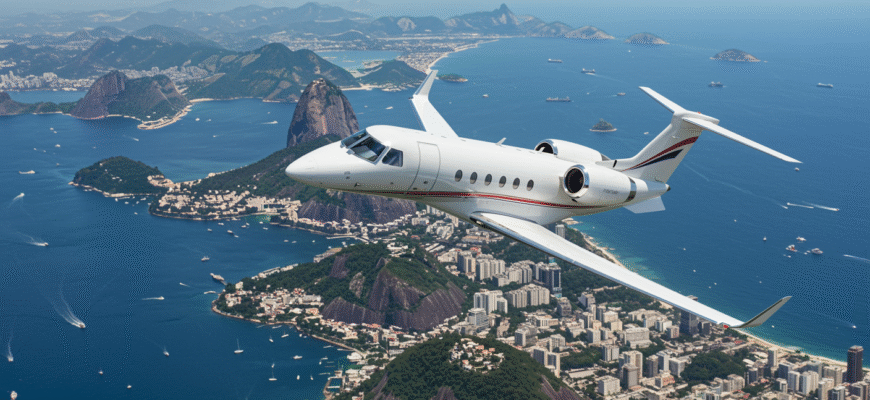Chartering a private jet to Rio de Janeiro isn’t just the type of adventure reserved for billionaires and Bond villains. Sure, there’s the perfectly chilled Moët and the velvet upholstery, but between the glitz are high-stress logistics, split-second timing, and aircraft limitations that feel more like a chess match than a luxury escape. Rio itself is a destination like no other––a pulsing city rimmed by ocean waves and rising jungle cliffs, with an energy that feels chaotic, seductive, and alive all at once. Flying in feels less like landing and more like being dropped into the middle of a party that never ends.
But here’s what most people don’t talk about: booking a private flight into Rio is part fantasy, part strategy. There’s no one-size-fits-all here. From dodging Brazilian weather drama to timing your descent for a fly-by of Christ the Redeemer, a private flight into Rio is thrilling—and at times, completely nerve-wracking. Which jet can land at which airport? Will your pilot be certified for the short SDU runway? Is your $100K quote even real? This isn’t just about comfort. Jetting into Rio is a blend of art, risk, skill, and just a touch of madness.
Booking A Private Jet To Rio: Price Tags, Hacks, And Hidden Realities
Most people think booking a jet to Rio means dropping six figures and moving on. But truth is, there’s a sneaky world behind the price tag—and some of it can work in your favor.
- Standard pricing will make your jaw drop: A one-way flight from Miami to Rio on a large jet? Expect $85,000 to $120,000. London to Rio? Welcome to the $180K club.
- Domestic hops (like São Paulo to Rio) are more manageable, clocking in at $6,000 to $12,000 for a light jet, perfect for cutting through traffic and skipping airport chaos.
- What you pay depends on: the aircraft model, location, fuel costs, day of the week, and of course, whether you’re flying during Carnival (a chaotic pricing mess).
Still, there are ways to play the game.
Empty leg flights are the sweet spot. These are discounted one-way trips when the aircraft needs to reposition—with discounts reaching up to 75%. Snag a $25K flight from Rio to New York just because someone else booked the return leg? Yes, please. But there’s a tradeoff: flexibility. If you can drop everything and go within hours, these deals are gold. If you need guarantees, skip it.
Who’s running this world? A mix of big and boutique players. Think VistaJet, Air Charter Service, and local Brazilian providers like Flapper and Icon Aviation. The big boys handle Carnival traffic like pros, but smaller providers often scoop up clients looking for private escapes between seasons.
Sneaky fees? Watch out for customs delays, landing permits, overnight crew stays, fuel surcharges, and even catering markups if you ask for non-local wine. Also, if your trip stretches over a multi-day wait for the jet, you pay layover fees—and they get steep fast.
| Segment | Aircraft Type | Estimated Cost | When to Book |
|---|---|---|---|
| São Paulo → Rio | Light Jet | $6,000 – $12,000 | Same-day or 24–48 hrs |
| Miami → Rio | Large Jet | $85,000 – $120,000 | 7+ days in advance (unless using empty leg) |
| London → Rio | VIP Airliner | $110,000 – $180,000+ | Peak season: book weeks in advance |
Biggest reality check? You’re paying for more than a seat. You’re paying for crew wait time, jet repositioning, certifications for pilots who can land at tricky terrain airports, local airspace navigation, and yes—keeping your rosé cold at 40,000 feet.
Jet Capabilities & Runway Limitations: What Can Actually Land In Rio?
Not every jet can touch down in Rio like a movie climax. The city’s two main airports—Santos Dumont (SDU) and Galeão International (GIG)—offer vastly different challenges.
SDU sits smack in the middle of the city. It’s beloved for its views (Sugarloaf Mountain and Guanabara Bay aren’t subtle), but cursed for its ultra-short runway—just 1,323 meters with little margin for error. Only certain light and mid-size jets can land there, and pilots need specific certification for the treacherous descent.
Heavy jets, like the Gulfstream G650 or the Bombardier Global 6000, head to GIG. Larger runway, fewer restrictions, more room to breathe. It’s your safest bet for long-haul flights or ultra-luxe jets with showers and lounges.
- Jets that fit into SDU: Learjet 45XR, Hawker 400XP, Phenom 300
- Jets best for GIG: Gulfstream G550, Falcon 900EX, Bombardier Global XRS
Don’t underestimate the drama—and skill—it takes to land in Rio. It’s not flying into JFK. It’s threading a metal bird between sky-high favelas, mountains, and ocean. Not every pilot is cut out for that.
The Descent into Rio: It’s Not Just a Flight, It’s Theater
Most people think of Rio de Janeiro as Carnival, Copacabana, and Christ the Redeemer. But ask any private pilot who’s flown into Santos Dumont Airport, and they’ll tell you: the real show starts in the sky.
Not every flight path gets you that famous slow dance with Christ the Redeemer—arms stretched wide, floating above the bay. It takes the right mix: decent weather, time of day, and crucially, the approach into SDU. This runway doesn’t mess around—it’s short, sits downtown, and is surrounded by water and high-rises. Only pilots with extra certification touch down here, and some say it’s better than any simulator.
A Gulfstream captain once called it “the most religious moment of my career.” Not for the views, exactly, but for the way it makes your body feel—suspended between ocean, jungle, and concrete towers. It’s part nature documentary, part video game—the kind of descent that snaps you awake and sets the tone. You’re not just arriving in Rio. You’re falling into it.
In-Flight Extras That Actually Matter
It’s easy to assume that once you’re flying private, life is smooth skies and top-shelf everything. But it’s not always pinot and playlists up there.
Your favorite wine? Scratched. Depending on where your jet last docked, customs might ban it. Brazil has strange rules—some petty, some hardcore. If you’re halfway through a killer bottle of Barolo, don’t be shocked if it doesn’t make it past Rio’s runway. Jet restocking depends heavily on local vendors, too. Some airports are fast. Others… not so much.
- Jet size = service level: Smaller jets? It’s likely just the pilot and a co-pilot. No one passing champagne flutes or fluffing blankets. Larger jets = full staff, full service.
- Pet travel quirks: Brazil gets picky. Some breeds aren’t allowed in. Others require stupid amounts of paperwork nobody warned you about.
- Luggage watch: Don’t count on sneaking through with exotic meats, certain meds, or “plant-based souvenirs.” Customs has a sharp nose.
Still, not every jet gets flagged. There’s an unspoken roulette in Brazilian customs. Some flyers bring guitars, drones, or full DJ rigs, and walk right through. Others lose half their suitcase. It’s a gamble—with or without snakeskin boots.
Jet Safety, Pilots, and Trusting the Ride
People obsess over Wi-Fi and window shapes, but miss the main question: who’s flying this thing?
Flying into Rio, especially SDU, isn’t casual. That short runway’s not forgiving. Pilots need serious hours logged and special landing rights just to make the approach. If you’re nervous, ask direct: how many landings has your pilot done here? It matters.
There’s also a shadowy side to luxury charters—ghost operators who skip proper insurance or use unlicensed jets. Before throwing down six figures, doublecheck: is this jet insured? Is it part of a registered fleet? Don’t assume professionalism just because the cabin smells like leather and lavender.
Real trust means vetting. Ask the hard stuff before takeoff.









